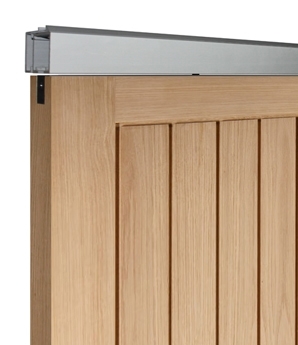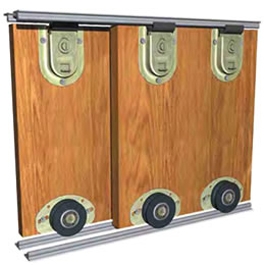We often get asked what the differences are between top hung or bottom rolling sliding systems. In this blog we will be looking at the main differences between them, as well as some advantages of both types of systems.
Top Hung Sliding Systems

Top hung systems are designed where doors hang from a track at the top, so that the top tracks bear all the weight of the door. The systems work so that the door is hung from the top but is guided at the bottom.
Top hung systems come with a bottom guide which is used to keep your doors sliding in a straight line, preventing the door from swinging out. There are different types of bottom guides, for more information on these see our blog post here.
Advantages
One advantage of using a top hung system is that they allow for optional extras such as soft close carriages and simultaneous operators. They also allow for heavier doors than bottom rolling systems do. These systems are also a great option where floors are uneven or slanted, as they don’t require a bottom track to lie flat against the floor.
Disadvantages
A disadvantage of a top hung system is that if you want the door to have extra support, a full-length floor guide will have to be purchases in addition to the system. It is also harder to add extra seals, such as weather sealings, on a top hung system compared to a bottom rolling.
Bottom Rolling Sliding Systems

Bottom rolling systems allow doors to slide seamlessly on full length tracks in the floor, being guided by a top channel which is not weight bearing. Two wheels run along the bottom track, these support the weight of your door whilst the top track is used as a guide.
Bottom rolling systems come with bottom and top tracks, top guides which are fitted to the top of the door, and bottom running wheels which are fitted to the bottom. It is important to note that the tracks must be parallel to one another when fitting a bottom rolling system.
Advantages
An advantage of using a bottom rolling system is that they are generally easier to install than top hung systems. They are also great for wardrobe systems as they allow the doors to slide all the way from one side of the track to the other. The tracks on bottom rolling systems are also a lot smaller, so they may be less noticeable and bulky looking. These systems are great where you have a false ceiling or plasterboard walls as they will not bear any of the weight, as the bottom tracks carry the doors weight.
Disadvantages
One disadvantage is that they require a lot more maintenance, it is important to ensure that the floor channels are clean and free of any dirt and debris, because if this builds up it can block the channels and cause the doors to get stuck. Bottom rolling systems also require a bit more force to open the doors, due to the top not being weight bearing. Another disadvantage is that thinner doors, such as doors made from MDF, can bow or warp, because the weight is not being supported from the top. Finally, the final disadvantage of bottom rolling systems is that the tracks in the floor must be stepped over, as they are not flush to the floor, this could be a potential trip hazard.
If you require any further information please do not hesitate to contact us by telephone or e-mail and we will be happy to help you.
Like us on Facebook for news and updates!

